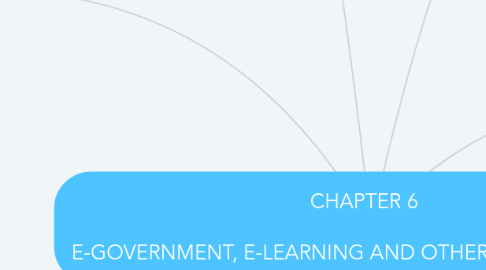
1. Electronic books
1.1. A book in digital form that can be read on a computer screen or on a special device
1.1.1. Can be delivered and read in various ways: Web Access Web Download Dedicated Reader Web Server Readers can locate a book on the publisher’s Web site and read it there. The book cannot be downloaded. It may be interactive, including links and rich multimedia. Readers can download the book to a PC The book must be downloaded to a special device (an e-book reader) The contents of a book are stored on a Web server and downloaded for print-on-demand.
1.1.2. Most e-book require some type of payment. Readers either pay before they download a book from web site. Pay when order the special CD-ROM edition of e-book. All are cheaper than the hard cop
1.2. ADVANTAGES AND DISADVANTAGES OF E-BOOK Advantages (Readers) 1. Lower cost and portability Readers can carry as many as 200 books wherever they go. 2.Easy search capabilities and links 3.Easy downloading 4.Ability to quickly and inexpensively copy material 5.Easy integration of content with other text 6.Easy updating 7.No wear and tear on a physical book 8.Ability to find out-of-print books 9.Books can be published and updated quickly ~ kept current 10.Reduce some of physical burdens of traditional books ~students 11.Multiple
1.3. ADVANTAGES AND DISADVANTAGES OF E-BOOK Advantages (Publisher) 1.Lower production, marketing and delivery costs. - Significant impact on the price of books. - E-textbooks are about 50 percent cheaper than print versions. 2.Lower updating and reproduction costs. 3.Ability to reach many readers. 4.The ease of combining several books. - Professor can customize textbooks by using materials from different books by the same publisher 5.Lower advertising costs.
1.4. Limitations 1.Require hardware and software that may be too expensive for some readers. 2.Some people have difficulty reading large amounts of material on a screen. 3.Battery may run down. 4.Competing standards ~ colour, format
2. E-learning
2.1. definition Web enabled system that makes knowledge accessible to those who need it, when they need it, anytime, anywhere. Appears in variety of format, ranging virtual classroom to mobile e-learning.
2.1.1. BENEFITS OF E-LEARNING
2.1.1.1. 1. Time reduction E-learning can reduce training time by 50 percents
2.1.1.2. 2. Large volume and diversity E-learning can provide training to a large number of people form diverse cultural backgrounds and educational levels even though they are at different locations in different zones.
2.1.1.3. 3. Cost reduction The cost of providing a learning experience can be reduced by 50 to 70 percent when classroom lectures are replaced by e-learning sessions.
2.1.1.4. 4. Higher content retention E-learning students usually are self-initiated and self-paced. Their motive for acquiring more knowledge may be to widen their scope of view or to develop career skills. Such self-motivation may result in content retention that could be 25 to 60 percent higher than with traditional lecturer-led training.
2.1.1.5. . Flexibility E-learners are able to adjust the time, location, content and speed or learning according to their own personal schedules. For example, if necessary, they can refer back to previous lectures without affecting the learning pace of other students.
2.1.1.6. 4. Updated and consistent material It is almost impossible to economically update the information in textbooks more frequently than every two or three years; e-learning can offer just-in-time access to timely information. E-learning may be more consistent than material presented in traditional classroom learning, because variations among teachers are eliminated.
2.1.1.7. Fear-free environment E-learning can facilitate learning for students who may not wish to join a face-to-face group discussion or participate in class. This kind of behaviour usually is attributed to their reluctance to expose their lack of knowledge in public. E-learning can provide a fear-free and privacy-protected environment in which students can put forth any idea without fear or looking stupid.
3. Distance Learning is Formal education that takes place off campus, usually, but not always, through online resources Virtual University is An online university from which students take classes from home or other offsite locations, usually via the Internet
4. Online Corporate Training Large number of business organizations are using e-learning on a large scale ~ offer online training. Example: CISCO, QANTAS AIRWAYS
5. GOVERNMENT-TO-BUSINESS (G2B)
5.1. Increase the ability for citizens and businesses to find, view, and comment on rules and regulations.
5.2. Reduce the burden on businesses by enabling online tax filling.
5.3. Reduce the time to fill up export forms and locate conformation
5.4. Reduce time for businesses to file and comply regulations
5.5. Make transactions with the government easier, cheaper, quicker and more comprehensible
6. E-Commerce model in which a government entity buys or provides goods, service or information to business or individual citizens.
6.1. Governments-to-citizens E-Government category that includes all the interactions between a government and its citizens.
6.2. Governments-to-business (G2B) E-Government category that includes interactions between government and business (government selling to businesses and providing them with services and business selling products and services to the government)
6.3. Governments-to-Employee (G2E) E-Government category that includes activities and services between government units and their employees.
6.4. Governments-to-Government (G2G) E-Government category that includes activities within government units and those between government.
7. CATEGORIES OF E-COMMERCE PERFORMANCE OBJECTIVES
7.1. Create easy to find single points of access to government services for individuals.
7.1.1. Improve the value of government to citizen
7.2. Reduce the average time for citizens to find benefits and determine eligibility
7.2.1. Expand access to information for people with disabilities
7.3. Increase the number of citizens who use the internet to find information and recreational opportunities.
7.3.1. Make obtaining financial assistance from the government easier, cheaper, quicker and more comprehensible.
7.4. Meet the high public demand for information
7.5. GOVERNMENT-TO-CITIZEN (G2C)
7.6. GOVERNMENT-TO-EMPLOYEES (G2E)
7.6.1. Increase availability of training programs for governments employees.
7.6.2. Reduce the average time to process clearance forms
7.6.3. Reduce the time for citizens to search for federal jobs.
7.6.4. Reduce time and overhead cost to purchase goods and services throughout the federal governments.
